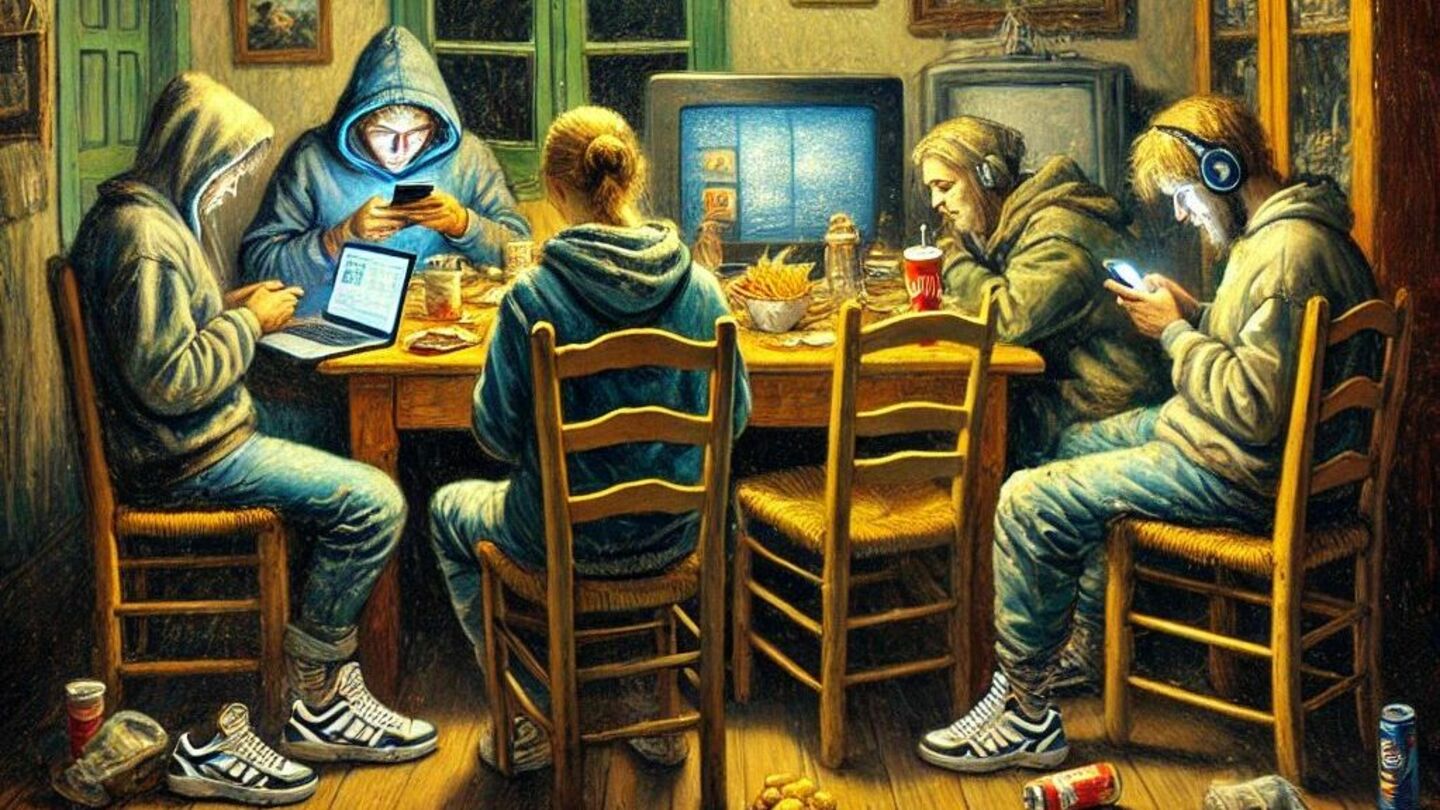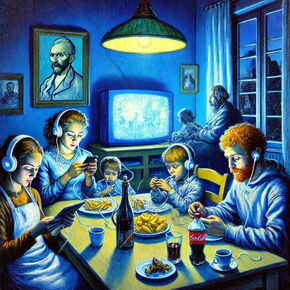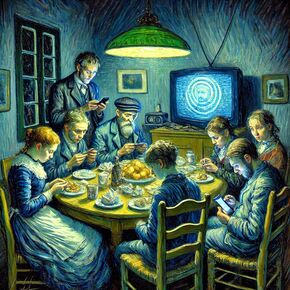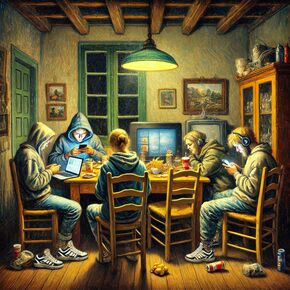
The enviable biorhythms of the potato eaters
Students create exhibit for Van Gogh Village Museum
What can the painting The Potato Eaters teach us about a healthy sleep-wake rhythm? Together with Van Gogh Village Nuenen, TU/e professor Yvonne de Kort came up with a challenge themed around this painting for Psychology & Technology students. The group that included Isha Rakhan and Tim Klein won. Their exhibition idea is being turned into a reality and will be on display at the museum in Nuenen after the summer. Because as it turns out, a flickering oil lamp above the dining table isn’t such a bad idea for our sleep.
By today’s standards, their diet was rather one-sided. Nevertheless, in terms of lifestyle, we can learn something from the potato eaters in the painting of the same name. The yellow glow of the oil lamp that Vincent van Gogh put on the canvas illustrates that they didn’t expose themselves – as we do – to the blue light of screens late at night.
It would be much better for our biorhythms to follow their example, says third-year TU/e student Isha Rakhan: “I myself consciously try to spend less time on my screens at night.” “In addition, make sure you get enough daylight during the day,” adds Tim Klein. The second-year student is from Zundert, the Brabant village where Van Gogh was born. An interest in the world-famous painter was instilled in him at an early age. “I immediately knew that I wanted to do this challenge.”
Vincent van Gogh in Nuenen
From the age of thirty, Vincent van Gogh lived in Nuenen for about two years. In that brief period, he was quite productive: he painted as much as a quarter of his oeuvre in the village northeast of Eindhoven. The best known Nuenen-based work is undoubtedly The Potato Eaters, a dark depiction of a local peasant family at dinner.
In Nuenen, you can learn more about Van Gogh’s life and work at the Van Gogh Village Museum. If you want to see the original potato eaters, go to the Van Gogh Museum in Amsterdam, or to the Kröller-Müller Museum, where an early version of the work is displayed.
Yvonne de Kort, who happens to live in Nuenen herself, is a full professor of Psychology of Light (IE&IS). The Van Gogh Village Museum asked for her expert assistance in developing the upcoming exhibition on light in Vincent van Gogh’s work. “Together we came up with the challenge for a challenge-based bachelor’s course I teach.”
Four groups of students participated, all of whom developed an interactive, multimedia museum display. The museum was most enthusiastic about the project of Rakhan, Klein, and their fellow students Luuk Tamerius, Maj Rokx, Emma Sluijs, and Boaz de Lange. Their idea will be part of the new exhibition that the museum is to open in September. The students will also be involved in its realization: “We’re working on it with an exhibit builder.”
Circadian
The purpose of the sub-exhibition is to teach visitors something about their own daily rhythm (aka ‘circadian rhythm’) through The Potato Eaters. De Kort: “The potato eaters spent entire days working outside in the fields, while we spend 80 to 90 percent of the time inside during the day.” Make no mistake: no matter how bright it appears inside, the daylight outside is easily 150 times stronger.
We need daylight to bring our biological clock back exactly in line with the natural day, the 24 hours it takes the earth to complete one rotation on its axis. “Without exposure to light and darkness, the internal clocks of most people deviate slightly from that natural day,” says De Kort.
In the evening, you produce melatonin so you sleep well. Except if you spend all evening on Netflix while scrolling on your phone, warns De Kort: “There’s a lot of blue in the spectrum of light from our screens, so our bodies react to it like daylight. That affects your sleep.”
Oil lamp
Each museum visitor is presented with an interactive quiz by the TU/e students, with questions about sleep, screen use, and more. Klein: “You then discover that our wake-sleep rhythm is no longer synchronized at all with sunrise and sunset, while nature does follow that rhythm. The potato eaters were also much closer to it.”
When it got dark, they went to bed rather quickly, because of melatonin production after a day outdoors, and also because the light from the oil lamp was too dim to read the newspaper by. The students were able to experience the latter for themselves.
“In Nuenen, someone has built a diorama of The Potato Eaters in their garden, allowing you to take your own seat at the famous table. There is a real oil lamp and the room can be darkened,” Klein says. During their visit, the students wore ‘light loggers’, small devices that record how much light the wearer is exposed to. “Those didn’t even react to the light coming from the oil lamp.”
Good atmosphere
Besides keeping us from sleeping, screens aren’t exactly known for contributing to a good atmosphere at the table. “The museum asked us to include that social aspect in our exhibit setup as well,” Rakhan says. “To get visitors thinking about this, after completing the quiz, they’re shown a picture of ‘their’ version of The Potato Eaters.”
Using AI, the students already created some examples of these modern potato eaters (see main and other photos). Instead of nineteenth-century farmers, we see modern families sitting at the table, whose members are completely engrossed in their phones or tablets. Van Gogh’s warm yellow light has been replaced by a cold blue glow.





Discussion